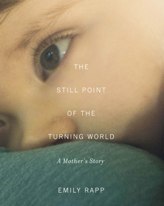All Faculty Excerpts
The Still Point of the Turning World
 Gotham teacher Emily Rapp recently released her memoir The Still Point of the Turning World: A Mother’s Story. The book recounts the months Emily and her husband spent with their child, knowing the child’s time on earth was limited. Emily kept notes, commenting that, “writing would not save Ronan. But, I thought, it might save me.” This is memoir at its most potent.
Gotham teacher Emily Rapp recently released her memoir The Still Point of the Turning World: A Mother’s Story. The book recounts the months Emily and her husband spent with their child, knowing the child’s time on earth was limited. Emily kept notes, commenting that, “writing would not save Ronan. But, I thought, it might save me.” This is memoir at its most potent.Here is the very opening:
###
This is a love story, which, like all great love stories, is ultimately a story of loss. On January 10, 2011, my husband Rick and I received the worst possible news: that our son, Ronan, then nine months old, had Tay-Sachs disease, a rare, progressive and always fatal condition with no treatment and no cure.I had been worried for some time. Ronan was experiencing developmental delays, missing important milestones. I would rush home from work each day hoping he’d started to crawl or had said his first word. He was the same sweet, happy, gurgling baby—but that was the problem. He was the same at nine months old as he had been at six months. Our pediatrician suggested that we rule out any vision problems, so we drove from our home in Santa Fe to the pediatric ophthalmologist’s office in Albuquerque.
I sat in the examination chair as the eye doctor, a short, friendly man with black glasses, played cartoons for Ronan on his I-Phone, and flashed a series of lights in Ronan’s eyes. “He’s got good fixation,” he said. Ronan squirmed in my lap. Great, I thought, he can see. But behind this feeling of relief was a surge of panic—why, then, was he having these delays? I handed Ronan to Rick and sat in a chair nearby.
“Let me just check his retinas,” the doctor said, and hit the lights. I could see Ronan’s little eyes flash in the dark, and then Rick’s. The doctor carefully approached Ronan and peered into his eyes using a special light.
“Oh, boy,” the doctor said. “Oh, boy,” was what my father had said when the doctors told my parents about my birth defect, which resulted in the amputation of my left foot. I gripped the sides of the chair and felt the floor drop away. The doctor flipped on the lights and said, “I’ve only seen this one other time.”
“What is it?” I asked, but I could see from his face that it was disastrous.
“Hey little guy,” Rick said, and turned Ronan to face him.
“Rick,” I said. My hands were sweating, trembling. “Rick!”
“He has cherry red spots on the backs of his retinas,” the doctor continued. “I’ve only seen this one other time in fifteen years of practice. It’s Tay-Sachs.” He paused. “I am so sorry.”
“What’s that?” Rick asked calmly, but then he quickly had to attend to me because I was wailing. I had wet my pants. The doctor calmly called for a nurse.
“I was tested!” I shouted. “I had the test.” I remembered the doctor asking, “Are you Jewish?” and shaking my head. “I want the Tay-Sachs test anyway,” I’d said. Or did I? Had I, in this moment, instantly generated a memory to try and mitigate the present horror?
“I don't know,” the doctor said uncertainly, and looked as if he might cry. I stared at him. “Did I?” I asked in a squeaky voice. He shook his head and cleared his throat. I would later learn that the standard pre-natal screening for Tay-Sachs only detects the nine most common mutations—
those found among the Ashkenazi Jewish population - when then are over 100 known mutations. I would have needed to ask for a combination DNA and enzyme test or requested that my DNA be sequenced. I had not known to ask for any of this. I was told the odds of my being a carrier were “astronomical,” and both parents must be carriers for a child to inherit Tay-Sachs. Although Rick is Jewish, by testing one of us, we thought we were covering our bases.
“My mom, my mom,” I said to Rick, gripping his arm and then taking Ronan from him. I clutched at my son, running my shaking hands over his head, his arms, his fat legs. “Little guy, little guy,” I said. He squirmed and giggled. I had the urge to swallow him, try to return him to my body where he’d be safe, but of course he’d never been safe, not even there. “Where’s my mom?” I was shouting now. “I need to call my mom. Where’s the phone? Give me the phone.”
###
Reprinted by permission of Penguin Press HC
For more information on Emily and her book, visit her website.
